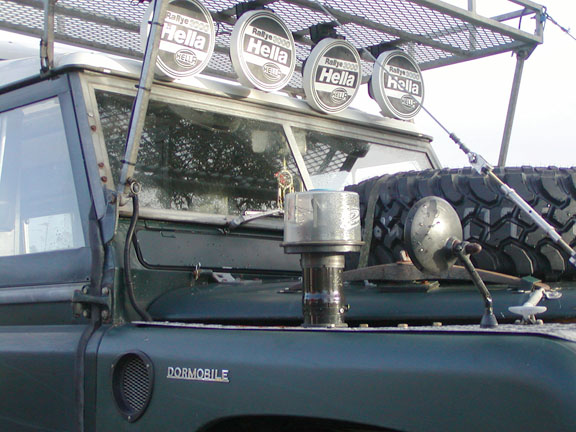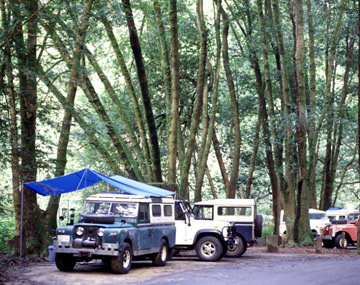I've tended to travel through many different types of ecosystems. My guidelines for modifications to my Dormobile reflect my attempts for trying to get through them with no or minimal damage. I also pack differently for different trips.
Areas of high rain fall
Areas of high rainfall tend to have dense plant and tree growth. This means trails are often narrow and overgrown. Brush pinstriping is pretty much a given and there are bigger branches reaching out as well. This kind of terrain tends to be bad news for wide vehicles such as Humvees. Your best bet are the narrower bodied vehicles such as the Series/Defender Land Rovers, FJ's & CJs. Longer wheelbase vehicles tend to be more stable in the mud and some trails but have a harder time negotiating tight turns through the trees that short wheelbase rigs go through with ease. You really have to choose your trails to match the absolute limits of your base vehicle, but there is a lot of things you can do to help your vehicle handle the trails with less chance of damage.
Anything hanging off the side is subject to branch strikes. Anything sticking out the side that presents a flat surface to the branches is subject to forceful removal.
When I designed my roof rack I made sure it stuck up an inch higher than the roof vent on my Dormobile roof.
I have added vertical pipes at both front corners in front of the leading edge of the front wings. A poor girl's brush guard. The pipe takes the initial branch strike and moves the branch aside so it can more easily slide along the side of the vehicle. Much better than denting up the leading corner of an aluminum wing panel.
In the above picture you will also see wire limb risers, which take the initial impact of limbs that would otherwise strike the windscreen and raises them up away from the windscreen glass. The limb riser top mounts are at the top of the roof rack which also tends to lift branches away from the roof rack front and helps keep the rack in place. Flat strikes to a rack can cause damage to the mounting points and push the rack back if not off the roof. Note that the limb riser wire is spring loaded, a trick I picked up from the Camel Trophy Defenders. The spring absorbs the force of larger branch strikes instead of the wire mounting points. I made my limb risers up from stainless steel marine rigging components.
Unprotected roof rack mounted auxiliary lights are subject to branch removal.
You want to mount them in a protected area
After about 20 years of driving my Land Rover without one I broke down and purchased a radio/MP3 player for my Dormobile. I installed a power radio antenna so that the antenna can be retracted inside the vehicle while driving through overgrown trails. My CB antenna is mounted on the back of the vehicle. A side mounted antenna tends not to survive long in overgrown trails and body damage can occur when they get ripped out.
My basic deign rules: armor the front to protect against brush strikes and keep the sides as clean as possible. Swing away mirrors are good. Desert rigs with jerry cans, spare tyres, antennas, ladders & such hanging off the side would have a hard time negotiating overgrown trails.
A winch comes in handy in areas of higher rainfall as does a high lift jack, a TruTrac front diff and tall tyres. Trails are often soft if not muddy and sometimes are deeply rutted. Another design rule of mine: Hangy down parts are bad and tend to either get the vehicle stuck or break off. So I try to have as clean an underside as possible. I've often wondered about vehicles with bottom shock mounts hanging down low.
A Trutrac helps your vehicle travel in the general direction that you point your front wheels and allows you to work your front wheels to try to get the best bight out of the edges of your front tyres. generally you try to stay out of deep ruts but sometimes you fall in. A 2 person recovery trick is to lay a sheet of plywood on the ground (I carry a 2 foot by 2 foot sheet) and set up a Hi-Lift at one end of the vehicle then lift the entire end of the vehicle up with someone leaning against one side to keep the vehicle from falling off the jack. When you get the vehicle up high enough just let it fall sideways off the jack onto higher ground and out of the rut.
When it comes to packing, humidity is a major issue. Wet clothing doesn't dry well in a humid environment. So I pack extra clothing instead of relying upon washing & drying clothing on the trail. I also carry extra small towels for wiping down surfaces. Dirty wet clothes are often best stored on the roof rack in a mesh bag. Every time you open your refrigerator you let in moist warmer air so expect to take an hour out ever 4 or 5 days to clean the excess water out of the refrigerator and to disinfect the inside walls. It is a good to carry a spray container of anti mildew disinfectant cleaner along.
Cotton is not your friend. It looses most of its insulating properties when wet. Wool is your friend. Polar fleece can be your friend. Polar fleece keeps its insulating properties when wet but is not resistant to wind. So if you are in any sort of breeze with polar fleece you want a wind proof shell worn over it.
Setting up camp in the rain can be a major trial in its self and one that everyone who travels in the area needs to cope with in their own way. One night in Oregon I tried to set up camp in a wind driven rain. I had a plastic trap awning erected & propane lantern lit. I was working on setting the lashing ropes when a big wind gust hit the unsecured part of the tarp awning, sent it flying, knocking over the propane light causing it to ignite the plastic tarp. The rain quickly put the fire out. I didn't have dinner that night and spent the night sleeping inside my Land Rover with all the gear that would normally be out under the awning. That was when I made the decision to turn my Land Rover into a motor caravan and started investigating ways I could move my camp inside my vehicle.
I was going to cover my thoughts about vehicle optimization, travel & camping through several different environments but this posting is getting very long without me completely covering just the Western high rainfall mountain environments. I'll close by saying that I have not nearly covered everything you should take into account when traveling just this one environment. There is so much more to say about treading lightly, treading safely and treading comfortably.
Each macro ecosystem has its own set of parameters that affect vehicle optimization, safety and comfort. Each has its own strong points and fragile parts that must be protected. You don't worry about keeping silt off salmon or steelhead eggs in deserts and you don't worry about preserving cryptobiotic crust in a rain forest (but the rain forest has its equivalent that you should worry about). I've found learning how to safely and responsibly travel different ecosystems to be a fascinating study.
Keep em coming as you think about them.


